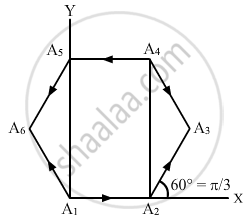Advertisements
Advertisements
प्रश्न
Let \[\vec{A} \text { and } \vec{B}\] be the two vectors of magnitude 10 unit each. If they are inclined to the X-axis at angle 30° and 60° respectively, find the resultant.
उत्तर
Angle between \[\vec{A} \text { and } \vec{B}\],θ = 60° − 30° = 30°
\[\left| \vec{A} \right| = \left| \vec{B} \right| = 10 \text { units }\]
The magnitude of the resultant vector is given by
\[R = \sqrt{A^2 + A^2 + 2AA\cos\theta}\]
\[ = \sqrt{{10}^2 + {10}^2 + 2 \times 10 \times 10 \times \cos 30^\circ}\]
= `sqrt(100 + 100 + 200 + sqrt3/2)`
= `sqrt(200 +100 xx sqrt3)`
= `sqrt(200 + 173)`
= `sqrt373`
= 19.3

Let β be the angle between
\[\vec{R} \text { and } \vec{A}\].
\[\therefore \beta = \tan^{- 1} \left( \frac{A \sin 30^\circ}{A + A \cos 30^\circ} \right)\]
\[ \Rightarrow \beta = \tan^{- 1} \left( \frac{10 \sin 30^\circ}{10 + 10 \cos 30^\circ} \right)\]
`beta = tan^(-1) (10 xx 1/2)/(10 + 10 xx (sqrt3)/2)`
`beta = tan^(-1) 5/(5(2 + sqrt3))`
`beta = tan^(-1) (1/(2 + sqrt3))`
\[ \Rightarrow \beta = \tan^{- 1} = 15^\circ\]
Angle made by the resultant vector with the X-axis = 15° + 30° = 45°
∴ The magnitude of the resultant vector is 19.3, and it makes an angle of 45° with the X-axis.
APPEARS IN
संबंधित प्रश्न
India has had a long and unbroken tradition of great scholarship — in mathematics, astronomy, linguistics, logic and ethics. Yet, in parallel with this, several superstitious and obscurantistic attitudes and practices flourished in our society and unfortunately continue even today — among many educated people too. How will you use your knowledge of science to develop strategies to counter these attitudes ?
Suggest a way to measure the thickness of a sheet of paper.
A physical quantity is measured and the result is expressed as nu where u is the unit used and n is the numerical value. If the result is expressed in various units then
Find the dimensions of the coefficient of linear expansion α and
Let I = current through a conductor, R = its resistance and V = potential difference across its ends. According to Ohm's law, product of two of these quantities equals the third. Obtain Ohm's law from dimensional analysis. Dimensional formulae for R and V are \[{\text{ML}}^2 \text{I}^{- 2} \text{T}^{- 3}\] and \[{\text{ML}}^2 \text{T}^{- 3} \text{I}^{- 1}\] respectively.
Test if the following equation is dimensionally correct:
\[v = \sqrt{\frac{P}{\rho}},\]
where v = velocity, ρ = density, P = pressure
Can you add three unit vectors to get a unit vector? Does your answer change if two unit vectors are along the coordinate axes?
Can you add two vectors representing physical quantities having different dimensions? Can you multiply two vectors representing physical quantities having different dimensions?
Can a vector have zero component along a line and still have nonzero magnitude?
If \[\vec{A} \times \vec{B} = 0\] can you say that
(a) \[\vec{A} = \vec{B} ,\]
(b) \[\vec{A} \neq \vec{B}\] ?
Let \[\vec{A} = 5 \vec{i} - 4 \vec{j} \text { and } \vec{B} = - 7 \cdot 5 \vec{i} + 6 \vec{j}\]. Do we have \[\vec{B} = k \vec{A}\] ? Can we say \[\frac{\vec{B}}{\vec{A}}\] = k ?
A vector is not changed if
A vector \[\vec{A}\] points vertically upward and \[\vec{B}\] points towards the north. The vector product \[\vec{A} \times \vec{B}\] is
A vector \[\vec{A}\] makes an angle of 20° and \[\vec{B}\] makes an angle of 110° with the X-axis. The magnitudes of these vectors are 3 m and 4 m respectively. Find the resultant.
A spy report about a suspected car reads as follows. "The car moved 2.00 km towards east, made a perpendicular left turn, ran for 500 m, made a perpendicular right turn, ran for 4.00 km and stopped". Find the displacement of the car.
Let A1 A2 A3 A4 A5 A6 A1 be a regular hexagon. Write the x-components of the vectors represented by the six sides taken in order. Use the fact the resultant of these six vectors is zero, to prove that
cos 0 + cos π/3 + cos 2π/3 + cos 3π/3 + cos 4π/3 + cos 5π/3 = 0.
Use the known cosine values to verify the result.

Write the number of significant digits in (a) 1001, (b) 100.1, (c) 100.10, (d) 0.001001.
